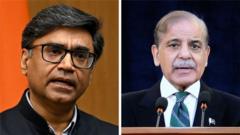A fragile peace emerges between India and Pakistan following a cease-fire, raising hopes for stability while underlying tensions remain.
**India-Pakistan Cease-Fire Brings Hope Amidst Tensions**

**India-Pakistan Cease-Fire Brings Hope Amidst Tensions**
Normalcy Returns as Both Nations See Economic Gains After Agreed Fighting Halt
Despite historic tensions, signs of a fragile peace emerged between India and Pakistan after a cease-fire agreement brought a halt to extensive fighting that had plagued the subcontinent. As financial markets in both countries rallied, civilian flights resumed, signaling a significant turn towards normalcy in a situation that had seen escalating military confrontation.
On Monday, stock markets surged as trading resumed, prompted by optimism that the cease-fire—announced late Saturday with U.S. mediation—would remain intact. Pakistani stocks hit a record high, with the Karachi 100 index soaring nearly 9% before trading was briefly halted. Meanwhile, India’s financial markets reflected a positive trajectory, largely erasing previous losses from the conflict.
Although many civilians remain displaced and the situation along the long border between the two nuclear neighbors remains delicate, there were no reports of significant violations of the cease-fire agreement on its second night. This precarious calm follows a week of intense military engagement after a terrorist attack in India-occupied Kashmir, which had escalated into aggressive retaliatory strikes by both sides.
The origin of the conflict stemmed from a devastating attack on Indian soil, which the government attributed to militant groups allegedly backed by Pakistan—a claim Islamabad has categorically denied. Following the attack, India responded with aerial bombardments targeting what were described as terror facilities deep inside Pakistan, leading to an unprecedented escalation in hostilities.
Both countries have a long history of sporadic confrontations, particularly over the disputed Kashmir region, which they claim in full but control in parts. However, last week’s exchanges represented the most serious military escalation in decades, characterized by drone attacks and heavy artillery shelling.
As military leaders from both sides planned discussions to assess the future of the cease-fire, there remains an air of uncertainty. While the immediate threat of renewed conflict seems to have subsided for now, the underlying tensions between India and Pakistan continue to simmer, leaving the potential for future clashes ever-present.
The U.S. role in mediating this cease-fire reflects a historical pattern of outside intervention in a bid to stabilize relations between the two countries. Moving forward, the focus will likely remain on restoring a more lasting peace and addressing the humanitarian situations that persist as a result of ongoing tensions in the region.
As analysts watch closely, the hope is that this recent agreement marks the beginning of a more enduring reconciliation process between the neighboring nations.
On Monday, stock markets surged as trading resumed, prompted by optimism that the cease-fire—announced late Saturday with U.S. mediation—would remain intact. Pakistani stocks hit a record high, with the Karachi 100 index soaring nearly 9% before trading was briefly halted. Meanwhile, India’s financial markets reflected a positive trajectory, largely erasing previous losses from the conflict.
Although many civilians remain displaced and the situation along the long border between the two nuclear neighbors remains delicate, there were no reports of significant violations of the cease-fire agreement on its second night. This precarious calm follows a week of intense military engagement after a terrorist attack in India-occupied Kashmir, which had escalated into aggressive retaliatory strikes by both sides.
The origin of the conflict stemmed from a devastating attack on Indian soil, which the government attributed to militant groups allegedly backed by Pakistan—a claim Islamabad has categorically denied. Following the attack, India responded with aerial bombardments targeting what were described as terror facilities deep inside Pakistan, leading to an unprecedented escalation in hostilities.
Both countries have a long history of sporadic confrontations, particularly over the disputed Kashmir region, which they claim in full but control in parts. However, last week’s exchanges represented the most serious military escalation in decades, characterized by drone attacks and heavy artillery shelling.
As military leaders from both sides planned discussions to assess the future of the cease-fire, there remains an air of uncertainty. While the immediate threat of renewed conflict seems to have subsided for now, the underlying tensions between India and Pakistan continue to simmer, leaving the potential for future clashes ever-present.
The U.S. role in mediating this cease-fire reflects a historical pattern of outside intervention in a bid to stabilize relations between the two countries. Moving forward, the focus will likely remain on restoring a more lasting peace and addressing the humanitarian situations that persist as a result of ongoing tensions in the region.
As analysts watch closely, the hope is that this recent agreement marks the beginning of a more enduring reconciliation process between the neighboring nations.






















